 ]
] IFIP Sumer School 2015 on Privacy and Identity Management. Time for a Revolution?, vol. 476, AICT Series, Springer, pp. 61-78, 07/2016.
IFIP Sumer School 2015 on Privacy and Identity Management. Time for a Revolution?, vol. 476, AICT Series, Springer, pp. 61-78, 07/2016.
10th International IFIP Summer School on Privacy and Identity Management, pp. 187-204, 2016. DOI
Abstract
Transparency and verifiability are necessary aspects of accountability, but care needs to be taken that auditing is done in a privacy friendly way. There are situations where it would be useful for certain actors to be able to make restricted views within service provision chains on accountability evidence, including logs, available to other actors with specific governance roles. For example, a data subject or a Data Protection Authority (DPA) might want to authorize an accountability agent to act on their behalf, and be given access to certain logs in a way that does not compromise the privacy of other actors or the security of involved data processors. In this paper two cryptographic-based techniques that may address this issue are proposed and assessed.
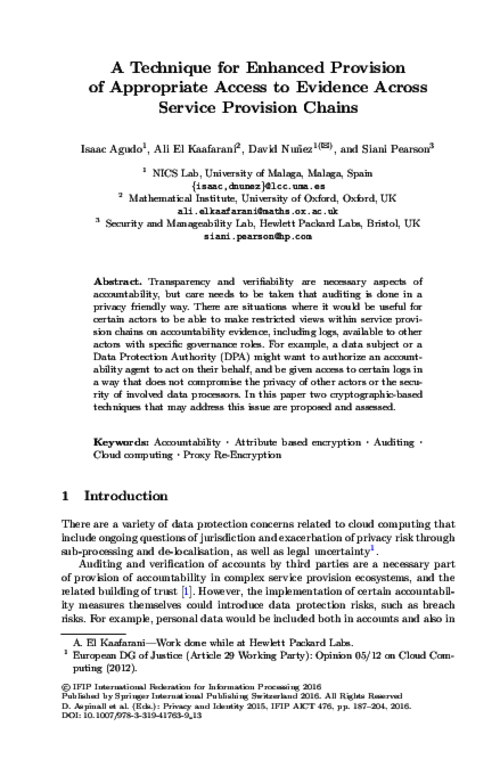
9th IFIP Summer School on Privacy and Identity Management for the Future Internet in the Age of Globalisation, vol. 457, Springer IFIP AICT, pp. 219-236, 2015. DOI
Abstract
Cloud computing is becoming a key IT infrastructure technology being adopted progressively by companies and users. Still, there are issues and uncertainties surrounding its adoption, such as security and how users data is dealt with that require attention from developers, researchers, providers and users. The A4Cloud project tries to help solving the problem of accountability in the cloud by providing tools that support the process of achieving accountability. This paper presents the contents of the first A4Cloud tutorial. These contents include basic concepts and tools developed within the project. In particular, we will review how metrics can aid the accountability process and some of the tools that the A4Cloud project will produce such as the Data Track Tool (DTT) and the Cloud Offering Advisory Tool (COAT).

XIII Reunión Española sobre Criptología y Seguridad de la Información (RECSI 2014), Universidad de Alicante, pp. 333-338, 09/2014.
Abstract
Continuamente aparecen nuevos estudios así como nuevos desarrollos de canales encubiertos. Como veremos, existen más de cien diseños distintos para redes de ordenadores, pero no hemos encontrado en la literatura ningún análisis, diseño e implementación de canales encubiertos sobre redes de sensores. En este artículo presentamos los resultados del diseño e implementación de un canal multitasa basado en los tiempos de monitorización sobre una red de sensores. En este proceso se han establecido las principales propiedades necesarias y, en base a ellas, se desarrolla e implementa el canal encubierto. Se describe el proceso de desarrollo y se analiza su detectabilidad.
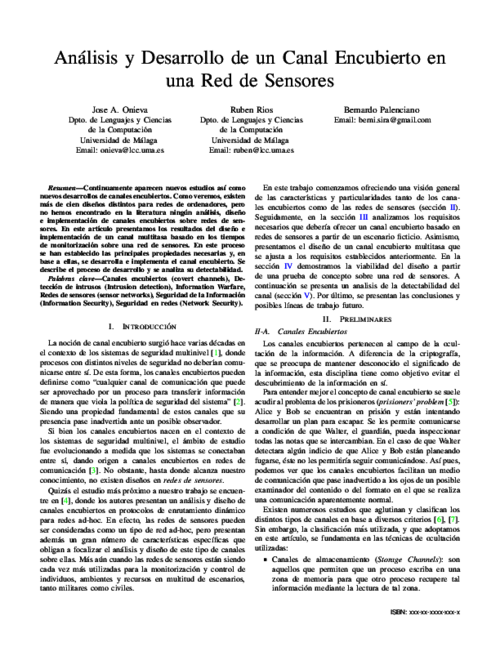
9th Future Security Conference, 2014.
Abstract
The rapid rate of change in technology and the increasing sophistication of cyber attacks require any organization to have a continuous preparation. However, the resource and time intensive nature of cybersecurity education and training renders traditional approaches highly inefficient. Simulators have attracted the attention in the last years as a potential solution for cybersecurity training. However, in spite of the advances achieved, there is still an urgent need to address some open challenges. In this paper we present a novel simulator that solves some these challenges. First, we analyse the main properties that any cybersecurity training solution should comprise, and evaluate to what extent training simulators can meet them. Next, we introduce the functional architecture and innovative features of the simulator, of which a functional prototype has already been released. Finally, we demonstrate how these capabilities are put into practice in training courses already available in the simulator.
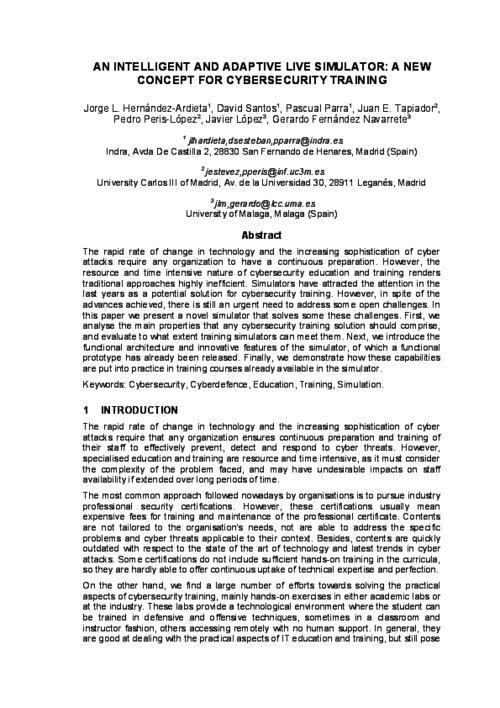
9th Future Security Conference, 2014.
Abstract
The rapid rate of change in technology and the increasing sophistication of cyber attacks require any organization to have a continuous preparation. However, the resource and time intensive nature of cybersecurity education and training renders traditional approaches highly inefficient. Simulators have attracted the attention in the last years as a potential solution for cybersecurity training. However, in spite of the advances achieved, there is still an urgent need to address some open challenges. In this paper we present a novel simulator that solves some these challenges. First, we analyse the main properties that any cybersecurity training solution should comprise, and evaluate to what extent training simulators can meet them. Next, we introduce the functional architecture and innovative features of the simulator, of which a functional prototype has already been released. Finally, we demonstrate how these capabilities are put into practice in training courses already available in the simulator.

8th International Workshop on Security and Trust Management (STM 2012), A. Jøsang, P. Samarati, and M. Petrocchi Eds., LNCS 7783, Springer, pp. 113-128, 2013. DOI
Abstract
During the last years, many trust and reputation models have been proposed, each one targeting different contexts and purposes, and with their own particularities. While most contributions focus on defining ever-increasing complex models, little attention has been paid to the process of building these models inside applications during their implementation. The result is that models have traditionally considered as ad-hoc and after-the-fact solutions that do not always fit with the design of the application. To overcome this, we propose an object-oriented development framework onto which it is possible to build applications that require functionalities provided by trust and reputation models. The framework is extensible and flexible enough to allow implementing an important variety of trust models. This paper presents the framework, describes its main components, and gives examples on how to use it in order to implement three different trust models.
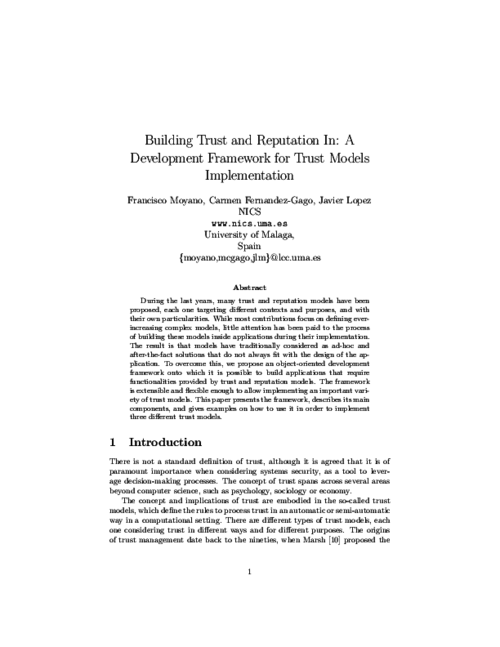
8th International Conference on Availability, Reliability and Security, IEEE, pp. 121-130, Nov 2013. DOI
Abstract
The number of insider threats hitting organizations and big enterprises is rapidly growing. Insider threats occur when trusted employees misuse their permissions on organizational assets. Since insider threats know the organization and its processes, very often they end up undetected. Therefore, there is a pressing need for organizations to adopt preventive mechanisms to defend against insider threats. In this paper, we propose a framework for insiders identification during the early requirement analysis of organizational settings and of its IT systems. The framework supports security engineers in the detection of insider threats and in the prioritization of them based on the risk they represent to the organization. To enable the automatic detection of insider threats, we extend the SI* requirement modeling language with an asset model and a trust model. The asset model allows associating security properties and sensitivity levels to assets. The trust model allows specifying the trust level that a user places in another user with respect to a given permission on an asset. The insider threats identification leverages the trust levels associated with the permissions assigned to users, as well as the sensitivity of the assets to which access is granted. We illustrate the approach based on a patient monitoring scenario.
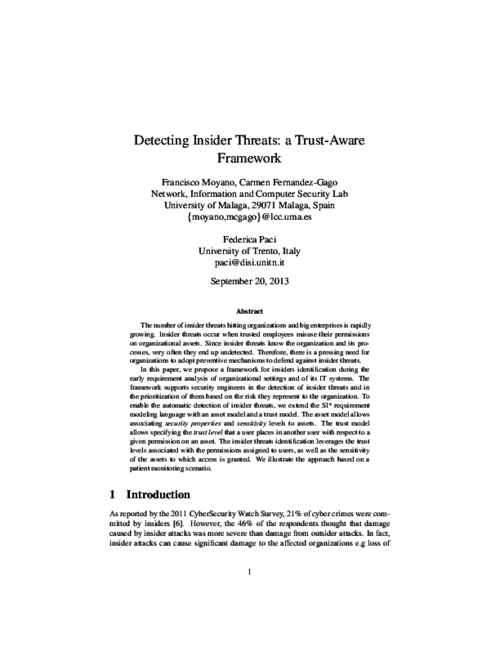
2013 IEEE International Conference on Cloud Computing Technology and Science (CloudCom 2013), IEEE, pp. 355-362, 12/2013. DOI
Abstract
Cloud governance, and in particular data governance in the cloud, relies on different technical and organizational practices and procedures, such as policy enforcement, risk management, incident management and remediation. The concept of accountability encompasses such practices, and is essential for enhancing security and trustworthiness in the cloud. Besides this, proper measurement of cloud services, both at a technical and governance level, is a distinctive aspect of the cloud computing model. Hence, a natural problem that arises is how to measure the impact on accountability of the procedures held in practice by organizations that participate in the cloud ecosystem. In this paper, we describe a metamodel for addressing the problem of measuring accountability properties for cloud computing, as discussed and defined by the Cloud Accountability Project (A4Cloud). The goal of this metamodel is to act as a language for describing: (i) accountability properties in terms of actions between entities, and (ii) metrics for measuring the fulfillment of such properties. It also allows the recursive decomposition of properties and metrics, from a high-level and abstract world to a tangible and measurable one. Finally, we illustrate our proposal of the metamodel by modelling the transparency property, and define some metrics for it.
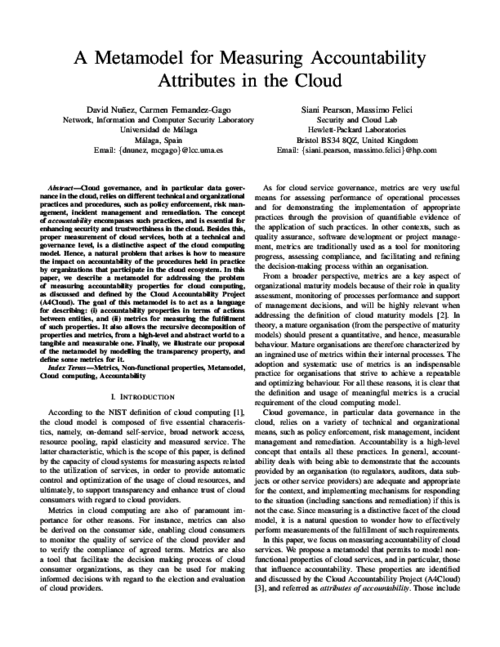
7th IFIP WG 11.11 International Conference on Trust Management (IFIPTM 2013), C. Fernandez-Gago, I. Agudo, F. Martinelli, and S. Pearson Eds., AICT 401, Springer, pp. 255-262, Jun 2013. DOI
Abstract
The Future Internet (FI) comprises scenarios where many heterogeneous and dynamic entities must interact to provide services (e.g., sensors, mobile devices and information systems in smart city scenarios). The dynamic conditions under which FI applications must execute call for self-adaptive software to cope with unforeseeable changes in the application environment. Software engineering currently provides frameworks to develop reasoning engines that automatically take reconfiguration decisions and that support the runtime adaptation of distributed, heterogeneous applications. However, these frameworks have very limited support to address security concerns of these application, hindering their usage for FI scenarios. We address this challenge by enhancing self-adaptive systems with the concepts of trust and reputation. Trust will improve decision-making processes under risk and uncertainty, in turn improving security of self-adaptive FI applications. This paper presents an approach that includes a trust and reputation framework into a platform for adaptive, distributed component-based systems, thus providing software components with new abilities to include trust in their reasoning process.
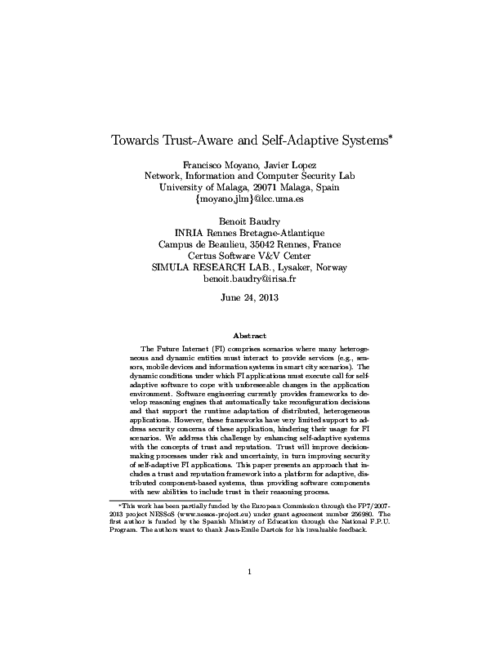
Information Security Solutions Europe 2012, N. Pohlmann, H. Reimer, and W. Schneider Eds., Springer Vieweg, pp. 195-206, 2012. DOI
Abstract
The paper describes the experience with integration of automatic cyber identity technology with policy controlled virtualisation environment. One identity technology has been used to enable strong authentication of users (human beings) as well as machines (host systems) to the virtualization management system. The real experimental evaluation has been done in PASSIVE project (Policy-Assessed system-level Security of Sensitive Information processing in Virtualised Environments - SEVENTH FRAMEWORK PROGRAMME THEME ICT-2009.1.4 INFORMATION AND COMMUNICATION TECHNOLOGIES - Small or medium-scale focused research project - Grant agreement no.: 257644).
Information Security Solutions Europe 2012, N. Pohlmann, H. Reimer, and W. Schneider Eds., Springer Vieweg, pp. 195-206, 2012. DOI
Abstract
The paper describes the experience with integration of automatic cyber identity technology with policy controlled virtualisation environment. One identity technology has been used to enable strong authentication of users (human beings) as well as machines (host systems) to the virtualization management system. The real experimental evaluation has been done in PASSIVE project (Policy-Assessed system-level Security of Sensitive Information processing in Virtualised Environments - SEVENTH FRAMEWORK PROGRAMME THEME ICT-2009.1.4 INFORMATION AND COMMUNICATION TECHNOLOGIES - Small or medium-scale focused research project - Grant agreement no.: 257644).
XVI Jornadas de Ingeniería del Software y Bases de Datos (JISBD 2011), Servizo de publicacións da Universidade da Coruña, pp. 487-491, 2011.
Abstract
Developing software through systematic processes is becoming more and more important due to the growing complexity of software development. It is important that the development process used integrates security aspects from the first stages at the same level as other functional and non-functional requirements. The identification of security aspects in the first stages ensures a more robust development and permits the security requirements to be perfectly coupled with the design and the rest of the system’s requirements. Systems which are based on Grid Computing are a kind of systems that have clear differentiating features in which security is a highly important aspect. Generic development processes are sometimes used to develop Grid specific systems without taking into consideration either the subjacent technological environment or the special features and particularities of these specific systems. In fact, the majority of existing Grid applications have been built without a systematic development process and are based on ad hoc developments.

1st International Workshop on Security and Trust for Applications in Virtualised Environments (STAVE 2011), C. Lee, J-M. Seigneur, J. J. Park, and R. R. Wagner Eds., Communications in Computer and Information Science 187, Springer, pp. 190-197, June, 2011. DOI
Abstract
In this paper we identify some areas where cryptography can help a rapid adoption of cloud computing. Although secure storage has already captured the attention of many cloud providers, offering a higher level of protection for their customer’s data, we think that more advanced techniques such as searchable encryption and secure outsourced computation will become popular in the near future, opening the doors of the Cloud to customers with higher security requirements.
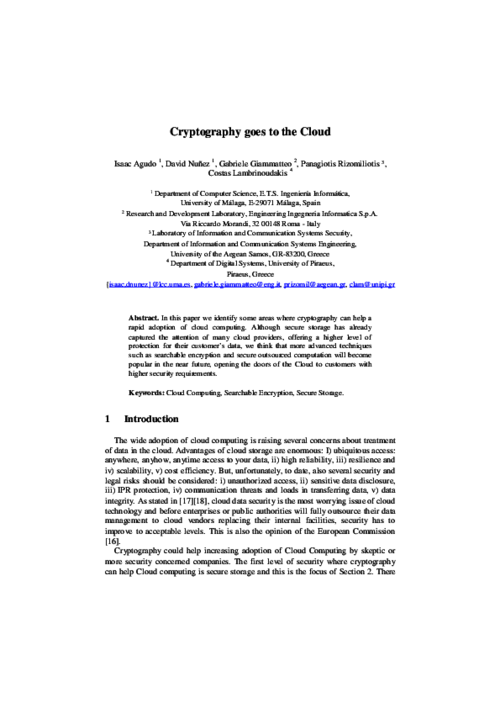
IX Jornadas de Ingeniería Telemenatica (JITEL 2010), Octubre, 2010.
Abstract
La confidencialidad ha pasado de ser un requisito de seguridad a ser considerado como requisito funcional y de obligado cumplimiento e inclusión en todos los sistemas de comunicaciones. Un inconveniente que presenta las técnicas criptográficas, utilizadas para obtener la confidencialidad de la información, surge cuando varias entidades se ven forzadas a compartir información secreta para realizar tareas puntuales de colaboración, ya que las primitivas tradicionales utilizadas para conseguir la confidencialidad resultan poco flexibles. La situación ideal permitiría hacer posible dicha colaboración sin que ninguna de las partes revele la información aportada. En este escenario entra en juego la tecnología de Computación Segura Multiparte (CSM) que posibilita realizar operaciones con la información compartida sin tener que hacerla pública. Este trabajo muestra una solución CSM aplicada a una subasta electrónica que permite la realización de la subasta sin que las apuestas sean reveladas a ningún participante, incluyendo el subastador, por lo que no necesita el estableciendo de ninguna autoridad confiable. Aunque la literatura ofrece una amplia variedad de propuestas teóricas de CSM desde su creación en la década de los ochenta, no es común su aplicacion práctica en situaciones reales.
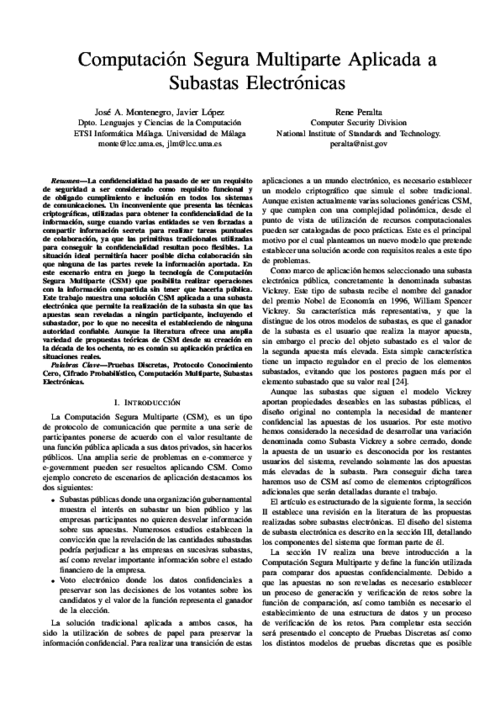
IX Jornadas de Ingeniería Telemática (JITEL’10), Y. Dimitriadis, and M. Jesús Ver Pérez Eds., pp. 237 - 244, Sept., 2010.
Abstract
Las aplicaciones basadas en localización proporcionan a los usuarios servicios personalizados dependiendo de su ubicación. Las estimaciones prevén que estos servicios se extenderán enormemente en los próximos años reportando grandes beneficios tanto a la industria como a los usuarios finales. Sin embargo, para que estos avances sean posibles se hace necesario analizar en profundidad las distintas implicaciones de seguridad y privacidad que la utilización de tales servicios pueden traer consigo a los usuarios. En este trabajo proponemos un sistema de localización que da soporte a la provisión de servicios basados en localización para entornos indoor y que se fundamenta en la tecnología de redes de sensores inalámbricos. En este esquema hemos tenido en cuenta diversos aspectos de seguridad y privacidad, prestando especial atención a la limitación extrema de recursos característica de las redes de sensores. Finalmente hemos desarrollado una prueba de concepto para comprobar la viabilidad de nuestro esquema dentro del ámbito del proyecto OSAmI.
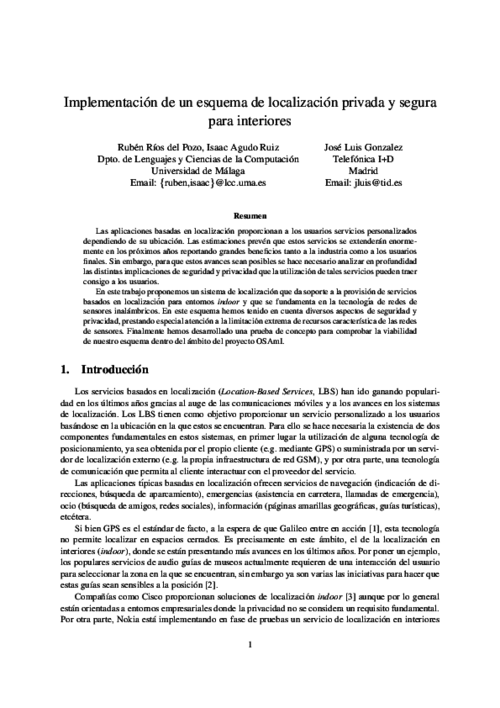
ICT Mobile and Wireless Communications Summit (ICT-MobileSummit’09), June, 2009.
Abstract
The increasing presence of embedded devices with internet access capabilities constitutes a new challenge in software development. These devices are now cooperating in a distributed manner towards what has been called as "Internet of Things". In this new scenario the client-server model is sometimes not adequate and dynamic ad-hoc networks are more common than before. However, security poses as a hard issue as these systems are extremely vulnerable. In this paper, we introduce SMEPP project, which aims at developing a middleware designed for P2P systems with a special focus on embedded devices and security. SMEPP is designed to be deployed in a wide range of devices. It tries to ease the development of applications hiding platforms details and other aspects such as scalability, adaptability and interoperability. A full implementation of this middleware is already available that incorporates security features specially designed for low-resource devices. Moreover, we describe two business applications being developed using this middleware in the context of "Digital Home" and "Environmental Monitoring in Industrial Environments".
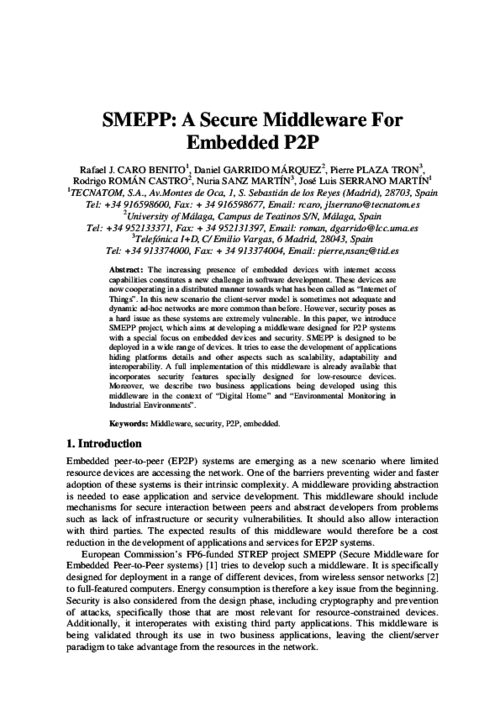
Third International Conference on Software and Data Technologies (ICSOFT’08), Springer, pp. 146-151, 2008.
Abstract
The interest to incorporate mobile devices into Grid systems has arisen with two main purposes. The firstone is to enrich users of these devices while the other is that of enriching the own Grid infrastructure.Security of these systems, due to their distributed and open nature, is considered a topic of great interest. Aformal approach to security in the software life cycle is essential to protect corporate resources. However,little attention has been paid to this aspect of software development. Due to its criticality, security should beintegrated as a formal approach into the software life cycle. We are developing a methodology ofdevelopment for secure mobile Grid computing based systems that helps to design and build secure Gridsystems with support for mobile devices directed by use cases and security use cases and focused onservice-oriented security architecture. In this paper, we will present one of the first steps of ourmethodology consisting of analyzing security requirements of mobile grid systems. This analysis will allowus to obtain a set of security requirements that our methodology must cover and implement.
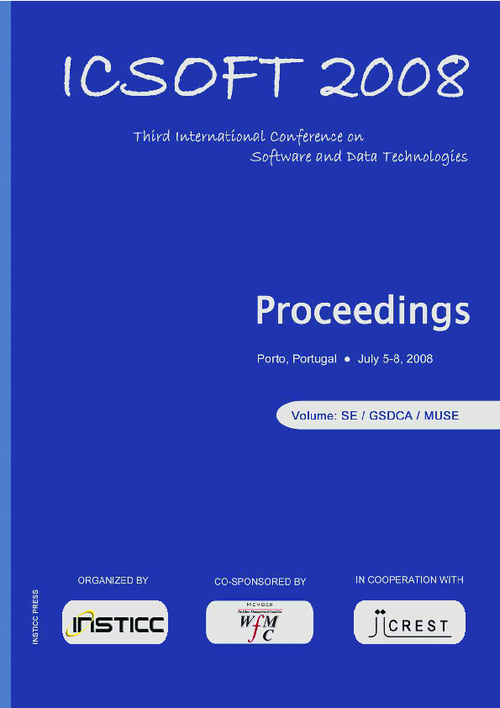
XVIII Jornadas Telecom I+D, October, 2008.
Abstract
Los sistemas distribuidos en dispositivos embebidos representan un nuevo reto en el desarrollo de software. Estos sistemas han supuesto una importante revolución en el paradigma de la computación distribuida donde se intenta fragmentar un problema grande en múltiples problemas más pequeños. El nuevo escenario tiende entonces hacia sistemas en los cuales todos los elementos de la red se consideran iguales y los mecanismos de comunicación estãn basados en redes ad-hoc que se forman dinámicamente. De esta forma cualquier usuario de la red (en realidad cualquier elemento, hasta el más simple dispositivo) adquiere valor, a mayor colaboración, mayor éxito del sistema. Sin embargo, desde el punto de vista de la seguridad, estos sistemas son extremadamente vulnerables. En este artículo se presenta SMEPP, un middleware diseñado especialmente para sistemas P2P incluyendo aspectos de seguridad. SMEPP está diseñado para poder ser ejecutado en un amplio rango de dispositivos (desde redes de sensores hasta PC), y trata de facilitar el desarrollo de aplicaciones ocultando los detalles de la plataforma y otros aspectos tales como escalabilidad, adaptabilidad e interoperabilidad. Además el artículo presenta dos aplicaciones de alto nivel que utilizando este middleware pasan a ser más personales, más sociales y más baratas, haciendo que todos los usuarios de la red cobren mayor importancia.
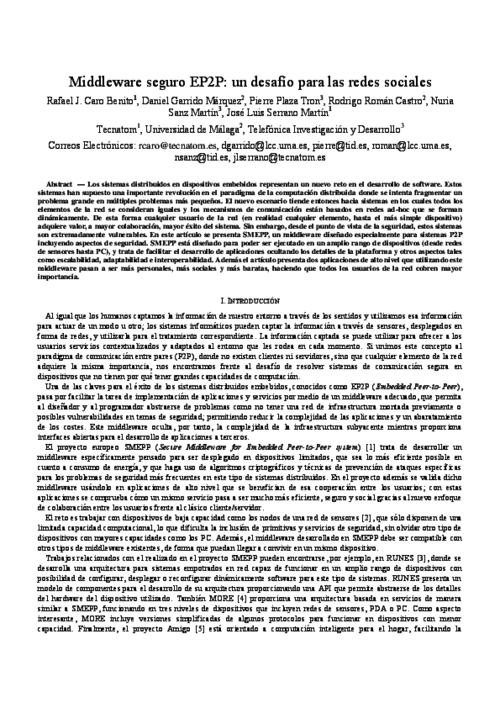
International Conference on Availability, Reliability and Security (ARES’08), IEEE Computer Society, pp. 136-143, 2008.
Abstract
A Grid computing system is defined as a platformthat supports distributed system applications which require fastaccess to a large quantity of distributed resources in acoordinated manner. With the development of wirelesstechnology and mobile devices, the Grid becomes the perfectcandidate so that mobile users can make complex works that addnew computational capacity to the Grid. Security of thesesystems, due to their distributed and open nature, receives greatinterest. The growing size and profile of the grid requirecomprehensive security solutions as they are critical to thesuccess of the endeavour. A formal approach to security in thesoftware life cycle is essential to protect corporate resources.However, little thought has been given to this aspect of softwaredevelopment. Due to its criticality, security should be integratedas a formal approach in the software life cycle. A methodology ofdevelopment for secure mobile Grid computing based systems isdefined, that is to say, an engineering process that defines thesteps to follow so that starting from the necessities to solve, wecan design and construct a secure Grid system with support formobile devices that is able to solve and cover these necessities.
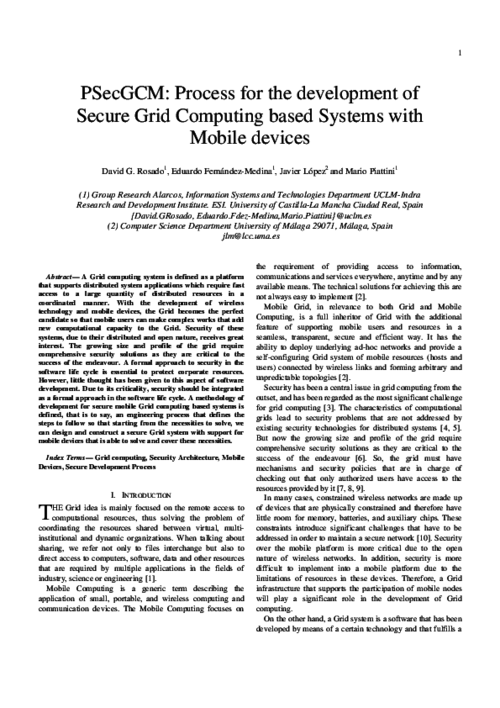
IV Congreso Iberoamericano de Seguridad Informática (CIBSI’07), Sebastián Cañón, M.A., pp. 111-124, 2007.
VI Jornadas de Ingeniería Telemática (JITEL’07), Universidad de Malaga, pp. 605-608, 2007.
Abstract
Sets of ideal properties are defined for different kinds of protocols designed for e-commerce applications. These sets are used as a start point in the design and then as a tool to evaluate the quality of the protocols. This is the case of fair exchange protocols and their application to electronic contract signing and certified electronic mail. However, in this area does not exist an agreement about which properties are ideal. Instead we can find properties described by different authors to his convenience. We illustrate the contradictions that appear between some of these properties.
2nd European PKI Workshop: Research and Applications (EuroPKI’05), LNCS 3545, Springer, pp. 135-143, June, 2005.
Abstract
In spite of the fact that there are several companies that (try to) sell public key certificates, there is still no unified or standardized classification scheme that can be used to compare and put into perspective the various offerings. In this paper, we try to start filling this gap and propose a four-dimensional scheme that can be used to uniformly describe and classify public key certificates. The scheme distinguishes between (i) who owns a certificate, (ii) how the certificate owner is registered, (iii) on what medium the certificate (or the private key, respectively) is stored, and (iv) what type of functionality the certificate is intended to be used for. We think that using these or similar criteria to define and come up with unified or even standardized classes of public key certificate is useful and urgently needed in practice.
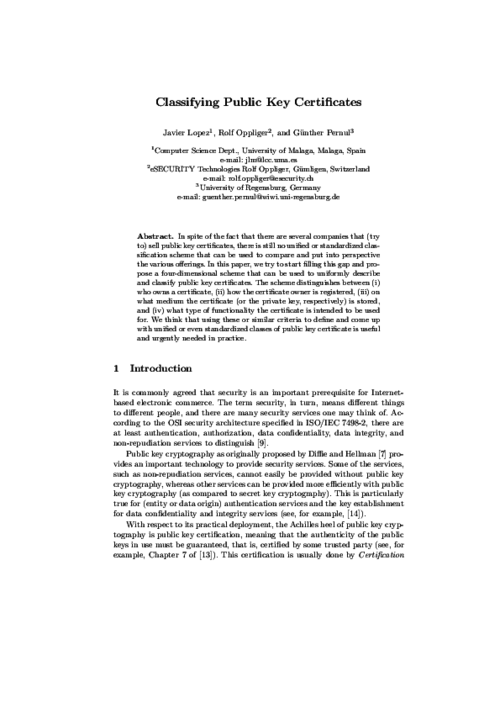
Fourth International Conference on Cryptology and Network Security (CANS´05), LNCS 3810, Springer, pp. 247-260, 2005.
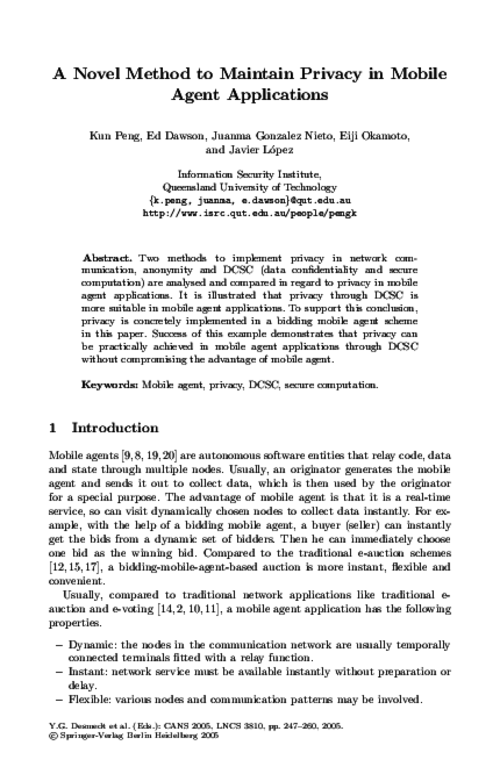
10th Panhellenic Conference in Informatics (PCI’05), LNCS 3746, Springer, pp. 548-558, November, 2005.
Abstract
An important aspect of e-business is the area of e-commerce. One of the most severe restraining factors for the proliferation of e-commerce, is the lack of trust between customers and sellers, consumer privacy concerns and the lack of security measures required to assure both businesses and customers that their business relationship and transactions will be carried out in privacy, correctly, and timely. This paper considers trust privacy and security issues in e-commerce applications and discusses methods and technologies that can be used to fulfil the pertinent requirements.
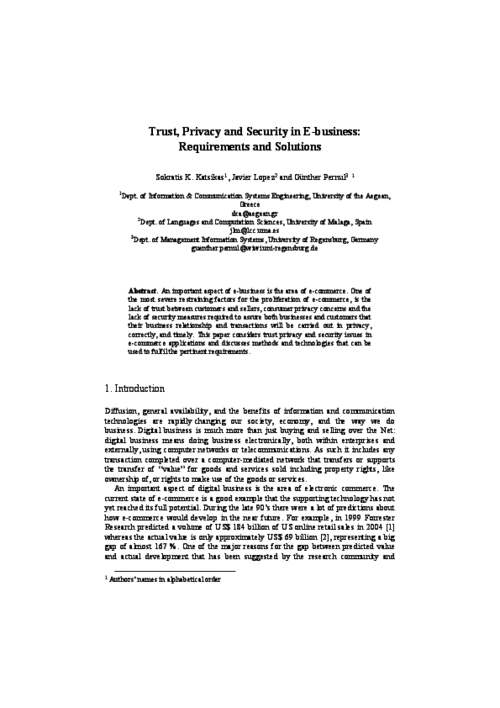
TERENA Networking Conference, June, 2004.
Abstract
In this work we elaborate on a taxonomy of systems that provide either joint solutions for both authentication and authorization problems, or solutions for only one of the problems. Basically, we do not focus our work on theoretical systems that have been proposed only in the literature. On the other hand, we focus on: (i) systems that are already developed; (ii) systems that are under development or deployment; and (iii) systems that are still in the initial stages of design but are supported by international working groups or bodies. More precisely, we elaborate on a taxonomy of systems that are (or will be soon) available to final users.
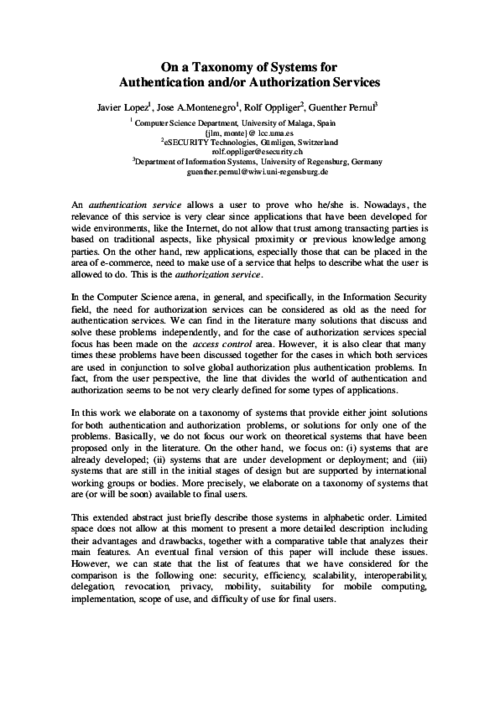
International Conference on Information and Communications Security (ICICS’02), LNCS 2513, Springer-Verlag, pp. 399-410, December, 2002.
Abstract
Distributed systems usually contain objects with heterogeneous security requirements that pose important challenges on the underlying security mechanisms and especially in access control systems. Access control in distributed systems often relies on centralized security administration. Existing solutions for distributed access control do not provide the flexibility and manageability required. This paper presents the XML-based Secure Content Distribution (XSCD) infrastructure is based on the production of self-protected software objects that convey contents (software or data) and can be distributed without further security measures because they embed the access control enforcement mechanism. It also provides means for integrating Privilege Management Infrastructures (PMIs). Semantic information is used in the dynamic instantiation and semantic validation of policies. XSCD is scalable, facilitates the administration of the access control system, guarantees the secure distribution of the contents, enables semantic integration and interoperability of heterogeneous sources, solves the “originator retained control” issue and allows activities (such as payment) to be bound to the access to objects.
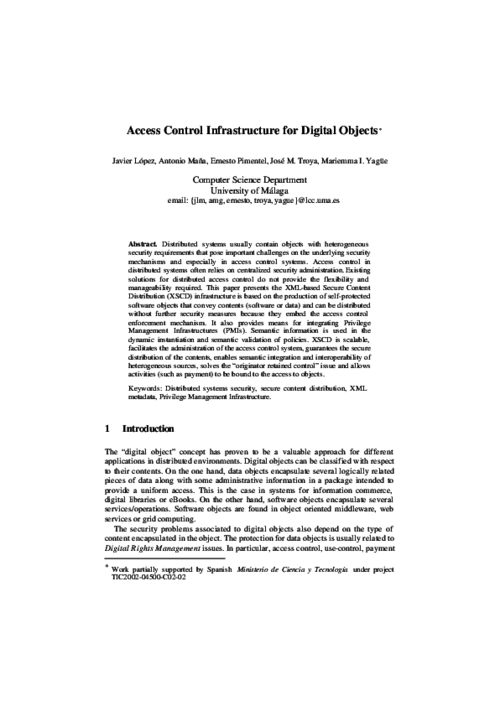
VII Reunión Española sobre Criptología y Seguridad de la Información (VII RECSI), pp. 485-497, Septiembre, 2002.
IFIP Conference on Security & Control of IT in Security, pp. 49-60, 2001.
VI Reunión Española de Criptología y Seguridad de la Información (VI RECSI), pp. 329-340, Sep 2000.
IEEE International Workshop on Electronic Commerce and Security, IEEE Press, pp. 850-857, September, 1999.
Abstract
The design of key distribution and authentication protocols has been shown to be error-prone. These protocols constitute the part of more complex protocols used for electronic commerce transactions. Consequently, these new protocols are likely to contain flaws that are even more difficult to find. In this paper, we present a search method for detecting potential security flaws in such protocols. Our method relies on automatic theorem proving tools. Among others we present our analysis of a protocol recently standardized by the German standardization organization DIN to be used in digital signature applications for smartcards. Our analysis resulted in the standard being supplemented with comments that explain the possible use of cryptographic keys.
5th Intern. Conf. on Computer Aided Systems Theory and Technology (EUROCAST’97), pp. 183-189, February, 1997.
Abstract
This paper is a first approach to the use of artificial neural networks as a tool to estimate the orientation of an object, and is mainly directed towards industrial applications. The capability of neural networks to generalise is a key element in the calculation of an object’s orientation. In this sense, a neural network can identify the angle of a part never seen before. To evaluate the efficiency of this method we have performed a series of tests with the different parts used in a car assembly line.
III Jornadas de Informática y Automática, pp. 423-432, Julio, 1997.
Abstract
A pesar del gran esfuerzo investigador llevado a cabo, el ataque al DES ha sido infructuoso desde que a mediados de los setenta fue adoptado como estándar por el U. S. National Bureau of Standards. El criptoanálisis diferencial constituye la base de las primeras técnicas capaces de acabar con tal invulnerabilidad. Las técnicas de criptoanálisis basadas en modelos de fallos y su adaptación a DES, el criptoanálisis de fallos diferencial, son dos de esas técnicas que han conseguido recientemente romper sistemas DES (aunque el ataque está limitado a ciertos casos especiales, en particular implementaciones hardware). En este artículo se presenta un punto débil de DES sobre el cual puede aumentarse la seguridad y se propone una modificación de la estructura interna de DES con objeto de mejorar su resistencia ante el criptoanálisis diferencial y por ende de los ataques derivados de este. La modificación introducida no supone un coste adicional elevado
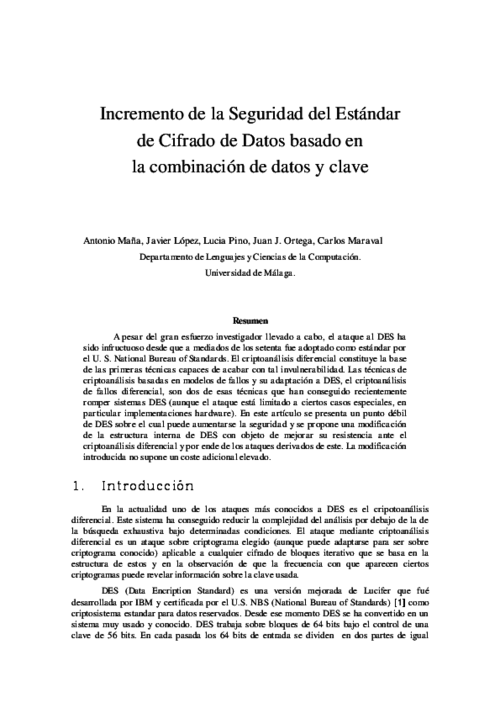
5th European Congress of Intelligent Techniques and Soft Computing (EUFIT’97), pp. 410-413, August, 1997.
Abstract
This paper is a first approach in the use of Neural Networks for security. We apply it for electronic mail private systems in Local Area Networks. Some of these systems use public keys directories which must be protected suitably. This task is very complicated because all users in the systems must be able to change their public keys in those directories. We see the advantage of using Neural Networks versus other classical methods to resolve this problem.
I Jornadas de Ingeniería Telemática (JITEL’97), pp. 295-302, Sep 1997.
5th European Congress of Intelligent Techniques and Soft Computing (EUFIT ’97), pp. 557-564, 1997.
IV Reunión Española de Criptología (IV REC), pp. 27-33, Septiembre, 1996.
Abstract
Nowadays cryptography is present in nearly every aspect of our everyday life, in particular public-key cryptosystems. Some of them have a mathematical foundation of number theory working with big integer numbers. Factoring these numbers is more complex and time-consuming than generating and testing prime numbers; this is the main reason for the strenght of some public key cryptosystems. This paper presents three different probabilistic methods for testing big prime numbers in a reasonable amount of time. A comparison of their efficiency to test prime numbers is also introduced.
X Symposium Nacional de la Unión Científica Internacional de Radio (URSI’95), pp. 147-150, Septiembre, 1995.